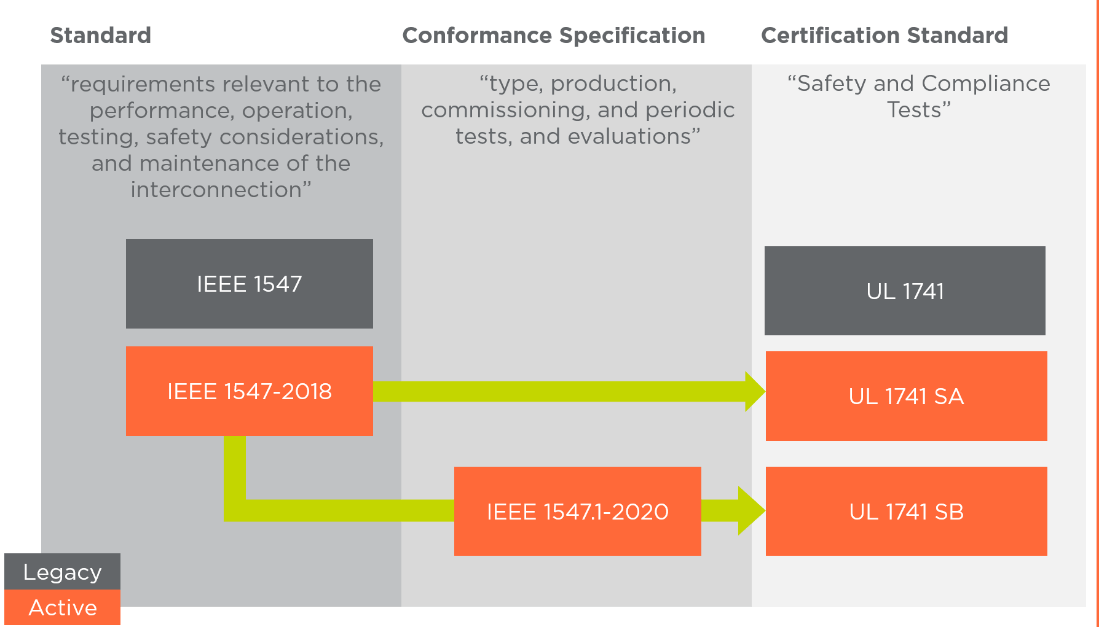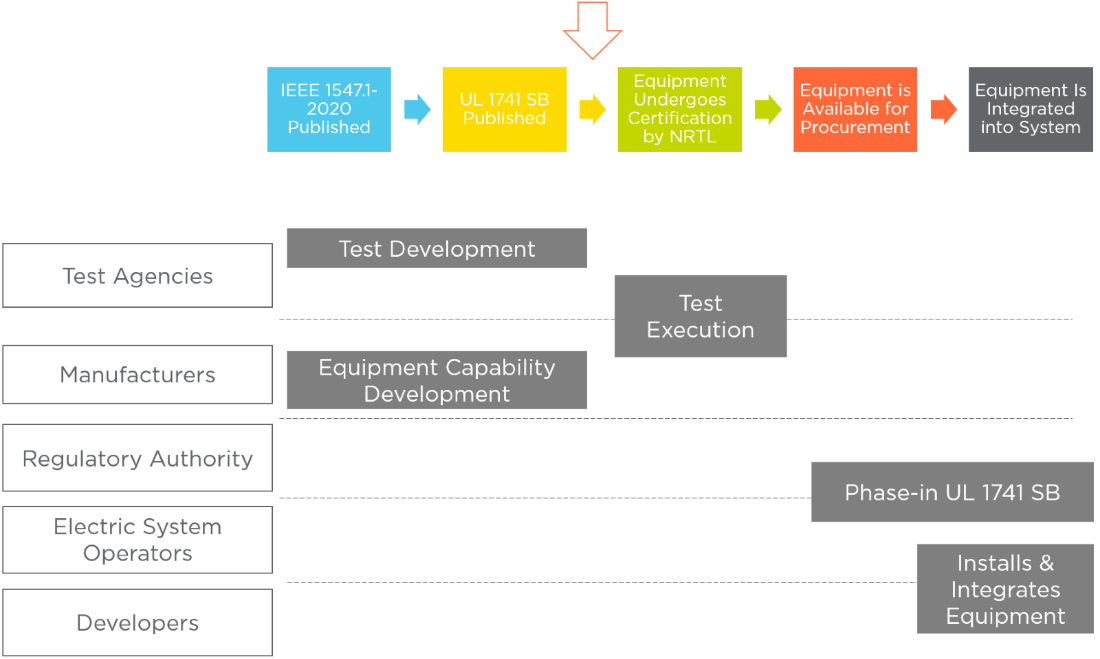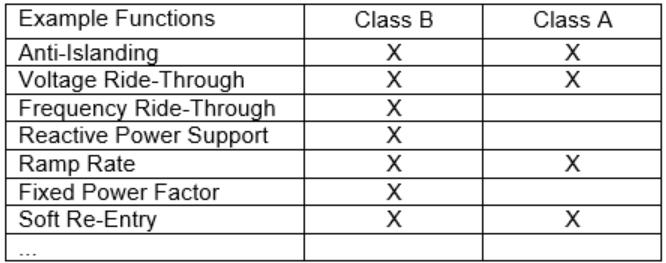Distributed Generation Grid Compliance and Certifications in US Electric Networks
Written by Dan Ernstmann
Distributed Generation (DG) interconnection rules and requirements have many inputs. Industry standards, regulatory requirements, local system engineering specifics, legal, and business practice cover a significant breadth of their construction. From the implementation perspective, the consistent global contribution to standards development and certification can seem like a vast, nebulous machine. Some contextualizing of this process can help give perspective and understanding to the end-user and enforcer.
Standardization and certification involve stakeholders from throughout the supply chain. These processes help signal requirements to manufacturers and testing agencies. Their adherence simplifies integration by providing uniform capability and performance expectations as well as consistent communications protocol for monitoring and control.
The publication of test standard IEEE 1547.1-2020 provides type tests (functions) and interoperability tests (communications, control, telemetry) for conformance with IEEE 1547-2018. Subsequently, UL 1741 SB will describe the testing methods and parameters to certify this conformance. This Language in interconnection rules and requirements is crafted by Electric System Operators (ESO) and regulatory authorities. Today interconnection requirements expect grid interactive devices to be UL 1741 SA certified and IEEE 1547-2018 capable. With the recent publishing of UL 1741 SB, we may see equipment meet this certification and be made available on the market within a year’s time.

Understand that the ESO expectation is that, fundamentally, grid-interacting generators reliably perform the capabilities described in IEEE 1547-2018. Equipment certification, when an NRTL tests these capabilities, has two inputs: (1) a testing standard, which defines capabilities, and (2) operating parameters, often dictated by a regional authority. Because the California and Hawaii markets have seen so much demand, the U.S. smart inverter market is predominantly certified to these rules’ parameters.

DER Project Impacts and System Implications
A developer or designer may propose a project with performance goals in mind but with flexibility for exact make, model, and components used in the construction. The current global supply chain strain helps demonstrate that by the time a developed, approved project procures materials and begins construction, the inverter or panel of design was not procurable. Generally, there is an expectation that these material modifications will not impact the grid-interoperability or physical constructability.
Expectations of grid-interactive capabilities is one critical “material modification” threshold and requires a re-assessment of the proposed projects’ accommodation on the grid. Consider families or classifications of “smart inverters” not just by their power ratings, but also by their grid-interactive functionalities or certifications.

Over the years, the area system will consist of various eras of distributed generation. Taking stock of waves of capabilities or installed-configurations can help build a picture of what advanced grid tools and strategies are available.
Note that Class A and Class B labels and subsequent functions are only intended to be illustrative of generations of equipment with different capabilities or configurations. These differences are defined by technology capability, regional regulatory configuration, and ESO interconnection requirements.

Modern inverter models will often demonstrate IEEE 1547-2018 capabilities, but documentation of system distributed resource capabilities is the first step in understanding system management.
From the Electric System Operator (ESO) perspective there are functions a distributed system is expected to perform and some functions that they may prefer. In many cases, an expectation that these systems are capable, prior to their being configured or leveraged, is common – as some capabilities may not be fully utilized until (1) DG penetrations meet a certain point, and (2) communications infrastructure and management platforms are implemented. But an ESO should be proactively thinking about these capabilities and setting expectations with customers that these can be enabled.
What kind of exceptions can be accommodated when equipment certification is not available? Non-compliant systems may be required to demonstrate capabilities and safety to the ESO. If willing to accommodate exceptions, the ESO should have an established process for self-certification. Non-inverter-based systems are often not inherently compliant and may need additional equipment, referred to as “supplemental DER devices” in 1547-2018, to be approved for interconnection. Alternatives or limitations such as non-export or disconnect for any grid event may be suitable in some systems, but these functions must be reliably demonstrated.
Conclusions
Practically, grid interactive distributed generation are held to these standards in anticipation that, if these decentralized resources become dominant sources on the network, they can participate in regulation of the grid.
- Many ESOs are exploring DERMS (DER Management Systems) for operational awareness, power quality sensitivity, and dispatchability. Understanding device setpoints is important for the incorporation of distributed generation.
- FERC 2222(a) introduces new value streams for aggregations of various types of DER and these will require coordination and interoperability.
- Microgrid systems and temporary island configurations are being designed and implemented. Telemetry and control capabilities offered by certified equipment provide the operational layers to make these sub-systems effective and reliable components of the grid.
The industry has these technologies at its fingertips, physically installed in their systems. Continue thinking ahead to realize possibilities in DER management through aggregation, configuration, and enablement of grid support capabilities.
This article edited by Doug Houseman.
To view all articles in this issue, please go to January 2022 eBulletin. For a downloadable copy, please visit the IEEE Smart Grid Resource Center.

To have the Bulletin delivered monthly to your inbox, join the IEEE Smart Grid Community.
Past Issues
To view archived articles, and issues, which deliver rich insight into the forces shaping the future of the smart grid. Older Bulletins (formerly eNewsletter) can be found here. To download full issues, visit the publications section of the IEEE Smart Grid Resource Center.




